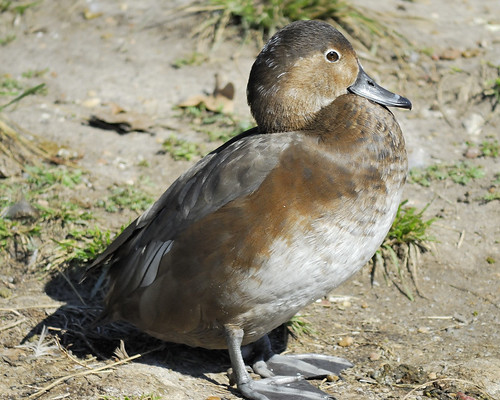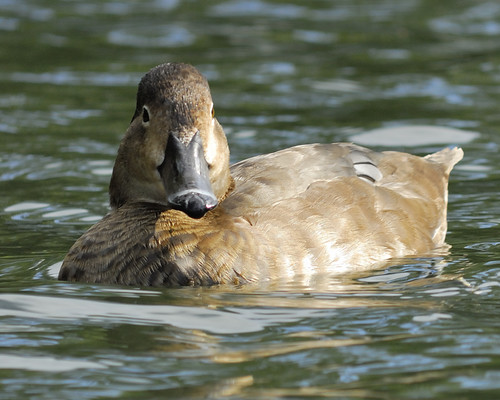tags: Redhead, Pochard, Raft Duck, Red-headed Raft Duck, Aytha americana, birds, mystery bird, bird ID quiz
[Mystery bird] Redhead, also known by a slew of other names, including Pochard, Raft Duck and Red-headed Raft Duck, Aytha americana, photographed in Hermann Park, Houston, Texas. [I will identify this bird for you in 48 hours]
Image: Joseph Kennedy, 23 December 2009 [larger view].
Nikon D200, Kowa 883 telescope with TSN-PZ camera eyepiece 1/500s f/8.0 at 1000.0mm iso400.
Please name at least one field mark that supports your identification.
Here's another image of a different individual to look at.
Redhead, also known by a slew of other names, including Pochard, Raft Duck and Red-headed Raft Duck, Aytha americana, photographed in Hermann Park, Houston, Texas.
Image: Joseph Kennedy, 21 November 2007 [larger view].
Nikon D200, Kowa 883 telescope with TSN-PZ camera eyepiece 1/180s f/8.0 at 1000.0mm iso400.
- Log in to post comments



Carolyn says female, ring-necked duck. White eye-ring, dark crown, bill pattern.
Agree with Russell, for exactly the same list of fieldmarks. I wish I could see the "tall rear crown", but the rest of the elements cited are good enough for me.
And what a nice photo!
I have 3 problems with the ring-neck ID. There should be a light patch at the base of the bill. Also, I don't see any sign of a "spur". And the head is very round. My first thought was redhead, but this duck looks much darker than "pale warm brown." And there is that eye-ring and dark crown.
I dunnno.
Isn't the pale streak from the top of the shoulder down and right a spur marking? Carolyn and I discussed that there wasn't much white at the base of the bill. But there is a bit. Could be wrong. Still my bet.
I agree with Lectric Lady, the round head, subdued bill pattern and lack of white at the bill base all suggest a female Redhead to me.
I'll go with female Redhead based on head shape and lack of pale markings on the head and broader bill
I'm afraid I'm going to go with Russell and John, and the distinction for me is quite clear:
the ring-necked female should have a brown head with a darker crown whereas the redhead female would have a reddish-brown head which would also extend to the neck and breast- the darker crown is obvious here...
the eye-ring on the ring-necked is distinct whereas that on the redhead would be indistinct and I clearly see an obvious and complete one here...
I don't think the stripe behind the eye is necessarily characteristic because I would expect that also on a redhead, similarly the bill color and faint white band near the tip should be present on both too, as well as gray feet, and a brown iris...
however I also think the remaining plumage is distinctively different on both species with our duck showing similar dark coloring as the redhead on top but clearly brown on the flanks transitioning to a light belly whereas on a redhead there is little contrast between the brownish flanks and the belly...
so I'm sure this is a female Ring-necked Duck, Aythya collaris.
And by the way, the white flecking on the bird's head above can be attributed to "adult status" in female Ring-necked Ducks as described in the Abstract to:
Hohman, W.L. and Cypher, B.L. (1986) Age-Class Determination of Ring-Necked Ducks
The Journal of Wildlife Management, 50 (3)442-445
I'm going to have to come down on the Redhead side of things. True, Sibley's shows a very evenly-plumaged Redhead, but Madge and Burn mention a distinctly darker crown on female Redheads. I'm also a bit confused about the sex of this bird. The back appears not to be darker, but conspicuously gray. This isn't typical for a female Redhead, but is for a male (although I don't see any vermiculations). On the other hand, every plumage in Ring-necked shows a black or blackish-brown back. This gray simply shouldn't be there. The face pattern is also exactly what I expect to see on a female Redhead around here in the winter, with a noticeable eyering, and with a fairly evenly-colored cheek and lores. The bill is wrong for any Ring-necked except a juvenile -- the white band should be much more noticeable. And I think the spur at the front of the undersides is actually a highlight on the feathers.
i have two photos of two different birds in almost identical poses ... and you're looking at one of those two images here.
hrm. i guess i should just stop telling you .. stuff, cuz, you know .. i might give things away to you ...
Hey Paul,
It seems to me that what we see mostly on the "back" is not the back but the flight feathers- the following photo records seem to reflect the same colors I am seeing here:
female Ring-necked Duck primaries
female Ring-necked Duck secondaries
David, the area around the shoulder may well be the lesser coverts, but that is still an area that should be much darker on a Ring-necked.
Thanks Paul, I guess they are so similar that too many slight changes between characteristics make this a conundrum for me- if Grrl was able to secure/post further photos of the same bird (I assume, as in other images, that the photographer might have several of the same individual) what other marks would you be looking for to confirm?
My understanding is that on the Redhead female we would expect to see a buff chin and throat, whereas on a Ring-necked we would perhaps see the same coloring (light brown) on cheek as chin but a darker throat towards the breast...
If there is a shot of the rear or back, are there any distinguishing marks (other than the color you questioned) that would determine one or other more easily? I have found accounts describing the Redhead female as having brownish-olive under the tail, with the Ring-necked umber-brown...
Are there obvious differences in the females' speculi with the Redhead's described as gray but that of the Ring-necked, bluish-gray, or is that too similar a description?
And although there are numerous records of Redhead x Ring-necked or Redhead x Canvasback or Ring-necked x Lesser Scaup hybrids and therefore assumed mixing of flocks and not just genes, as this is in the breeding season, if this individual was "dabbling" with a mate (Redhead or Ring-necked), or amongst a single species group, could that also be indicative?
oh, pooh! i went back to Joseph Kennedy's site to grab a couple more images of this individual bird for you to look at, but alas, he did not publish more images of this particular individual, so i cannot share them with you. i did dig up another photograph of a different individual that he snapped two years earlier in the same location that might be helpful.
one thing to keep in mind with the original mystery bird is that the bird is in moult: you can clearly see the new feathers on its head, and moult affects plumage color and brightness.
Hi Grrl, I too have visited Joseph Kennedy's site to try to get a better idea on how to look at ducks and noticed that someone, either here or there, has made a misidentification.
I don't know enough to tell the difference yet between ring-necked or redhead females when they are very similar (there seems to be a lot of variation) but in Joseph's albums he describes all four of these photos as "ring-necked ducks", not redhead or pochard and they seem to be the same individual you used on this blog!
Duck #1
Duck #2
Duck #3
Duck #4
maggie: well, you have me stumped.
this image is still labeled as a redhead, and i still think this is a redhead (face, beak and head coloring/pattern) but there is, as you say, a lot of variability as to be confusing. perhaps sussing out the redhead versus ring-necked duck ID is worthy of its own thread? if so, i'll have to rely on all you peeps to dig through your field guides to share relevant information (my complete extensive collection of bird field guides are here -- finally -- but alas, they're well buried somewhere in 100 boxes of books, so it will take me awhile to dig them all out.)